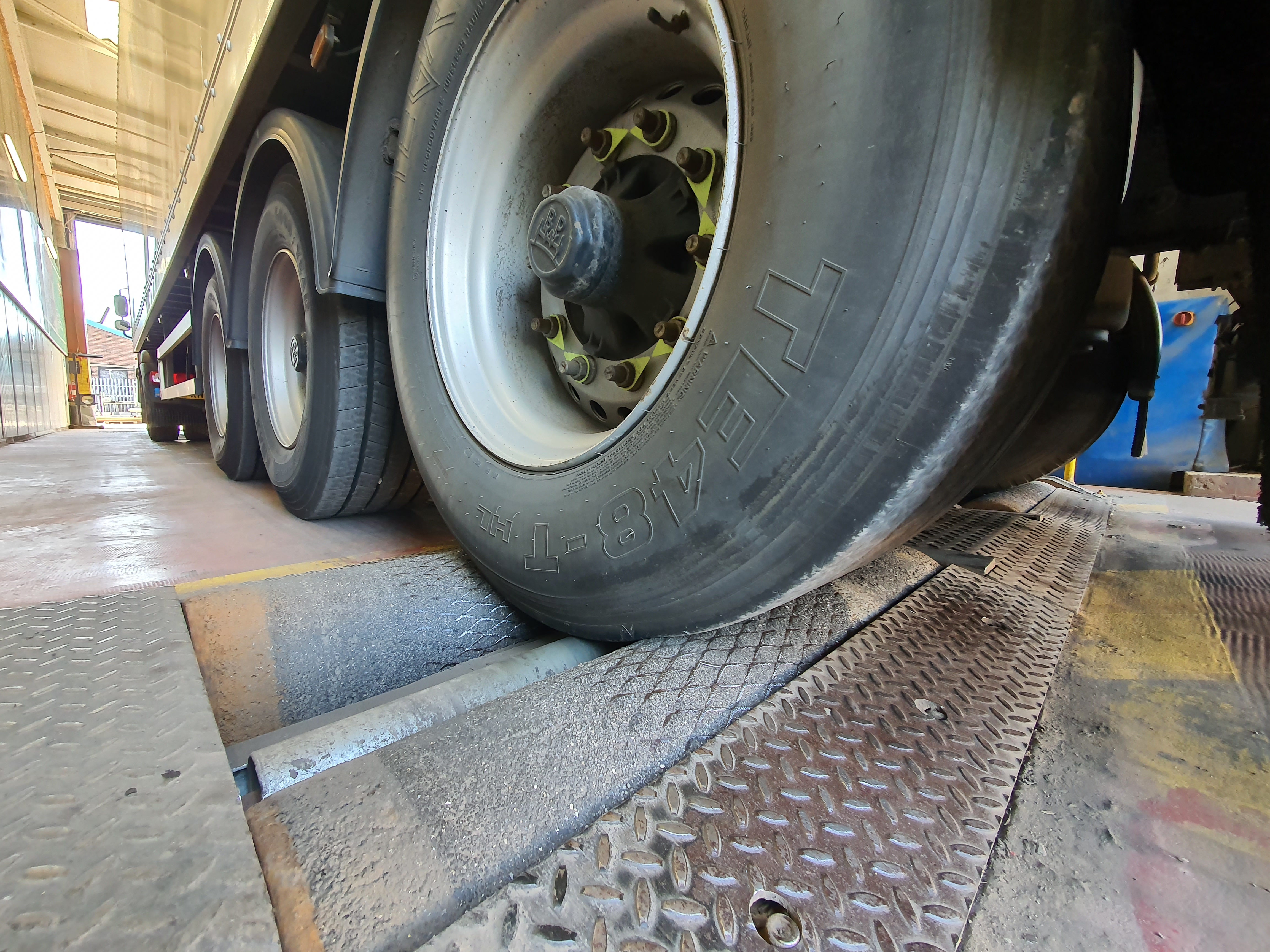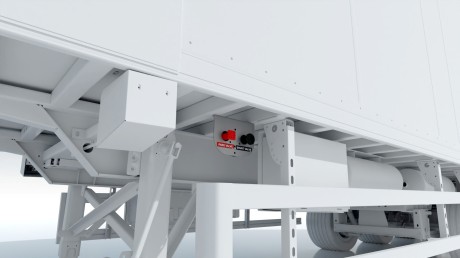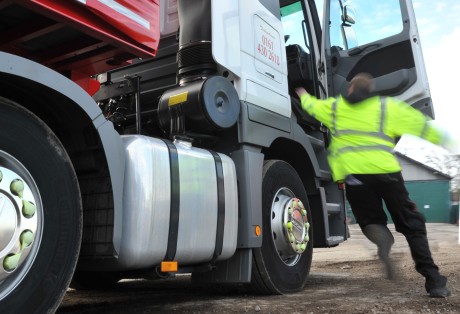A roller brake test is a vital procedure used to assess the braking performance of heavy goods vehicles (HGVs) and trailers. It measures braking force (in kilogram-force or kgf), efficiency, imbalance, and overall system condition — all critical for road safety and compliance.
To follow best practice and comply with legislation, the DVSA expects every safety inspection to include a brake performance assessment using either a calibrated roller brake tester (RBT), a suitable electronic brake performance monitoring system (EBPMS), or a decelerometer with brake temperature readings. From April 2025, brake tests must also be conducted in a laden condition unless valid exemptions apply. This article explains how roller brake testing works, why it’s necessary, and how to interpret test results under the latest expectations.
For detailed official guidance, refer to the DVSA Guide to Maintaining Roadworthiness.
Contents
- What is a Roller Brake Test?
- Legal Requirements for Brake Testing
- How is a Roller Brake Test Performed?
- What Does the Roller Brake Test Measure?
- Current Exemptions and the Transition to Risk Assessments
- Why is Laden Brake Testing Important?
- Understanding Your Roller Brake Test Report
- Final Thoughts
What is a Roller Brake Test?
A roller brake test measures the braking force applied by each individual wheelset while the vehicle remains stationary. The test is carried out using a roller brake tester (RBT), which simulates road conditions by rotating rollers under each axle while the brakes are applied. The resulting force is measured in kilogram-force (kgf).
Unlike road or decelerometer-based testing, roller brake testing offers a controlled, repeatable environment to assess brake efficiency, imbalance and any binding issues.
Legal Requirements for Brake Testing
Understanding the legal background helps operators appreciate why brake testing is so crucial and how enforcement is changing.
Construction & Use Regulations (Regulation 18)
Under Regulation 18 of The Road Vehicles (Construction and Use) Regulations 1986, operators must ensure that:
“Every braking system shall be maintained in good and efficient working order.”
DVSA’s “Guide to Maintaining Roadworthiness”
The March 2024 edition of the Guide sets out the following expectations:
- A brake performance assessment must be included at every safety inspection.
- The default method is a calibrated roller brake tester.
- From April 2025, all roller brake tests (including MOT) must be conducted with the vehicle or trailer laden to at least 65% of the design axle weight.
Where laden RBT isn’t practicable, alternatives are acceptable, provided they’re supported with documentation:
- An approved Electronic Brake Performance Monitoring System (EBPMS)
- A documented risk assessment by a competent person
- Decelerometer testing with brake temperature readings
Operator Licence Undertakings
Operators commit under their O Licence to keep vehicles in a fit and serviceable condition. Demonstrating meaningful brake performance testing — preferably laden — is a core part of this, and failing to meet expectations may trigger enforcement action or referral to the Traffic Commissioner.
How is a Roller Brake Test Performed?
- Vehicle Preparation:
- The vehicle is driven onto the roller brake tester.
- Each axle is tested separately, with individual wheelsets assessed.
- For trailers, an external air supply may be connected.
- Vehicles should be tested in a laden condition (ideally ≥65% of axle design weight).
- Axle-by-Axle Testing:
- Each axle is positioned on the rotating rollers.
- The rollers spin the wheels under controlled speed.
- Brakes are applied gradually, and the force output is measured in kgf.
- Data Collection:
- The brake tester records braking force, imbalance, binding, and lock-up.
- A pass/fail report is generated.
What Does the Roller Brake Test Measure?
Braking Efficiency
- Service brake: Minimum 50% efficiency
- Secondary brake: Minimum 25% efficiency
- Parking brake: Minimum 16% efficiency
Brake Imbalance
- Side-to-side differences over 30% may indicate instability and cause failure
Brake Binding
- Residual brake force after release may indicate sticking or mechanical faults
Current Exemptions and the Transition to Risk Assessments
Common Exemptions
Some vehicles have historically been tested unladen due to operational constraints, including:
- Tri-axle semi-trailers
- Livestock transporters
- Tanker trailers or ADR vehicles
However, these practices are under review. From April 2025, laden brake testing will be the default expectation, and operators must justify any deviation.
Risk Assessment Approach
If laden testing is not practical, operators must complete a documented risk assessment explaining:
- Why laden testing isn’t feasible
- What alternative method is being used (e.g. EBPMS)
- Evidence used to monitor and demonstrate brake performance
This document must be retained for at least 15 months and available upon request.
Why is Laden Brake Testing Important?
Brake performance under load is significantly different to when the vehicle is unladen. Testing without load can result in early wheel lock-up or under-readings — giving a false pass.
From April 2025, DVSA expects all roller brake tests — including MOT — to be conducted with the vehicle or trailer loaded to at least 65% of the design axle weight. This applies unless:
- The vehicle qualifies for an exemption and has a documented risk assessment
- An EBPMS is installed and provides continuous data
Operators must retain loading evidence, such as weighbridge tickets or load calculations, and test reports for inspection.
Understanding Your Roller Brake Test Report
Your roller brake test report will typically include:
- Overall pass/fail outcome
- Braking force per wheel (in kgf)
- Brake imbalance percentage per axle
- Lock-up detection and brake binding data
Ensure vehicle data (e.g. DTp number, axle weights, configuration) is correctly entered, or the results may be invalid.
Final Thoughts
Roller brake testing is central to safe and compliant vehicle operation. From April 2025, the expectation for laden RBTs will be formalised — and enforcement is expected to increase.
Now’s the time to review your brake testing procedures, prepare for loaded testing conditions, and ensure supporting documentation (or EBPMS data) is ready if needed. This proactive approach will help you stay ahead of regulatory changes and avoid potential compliance issues.
We’d love to hear from you – get in touch today!







